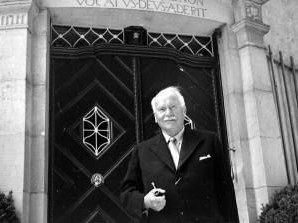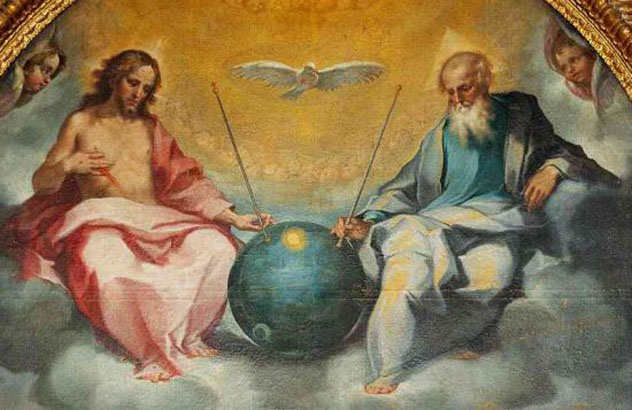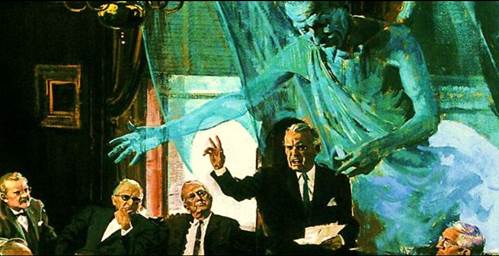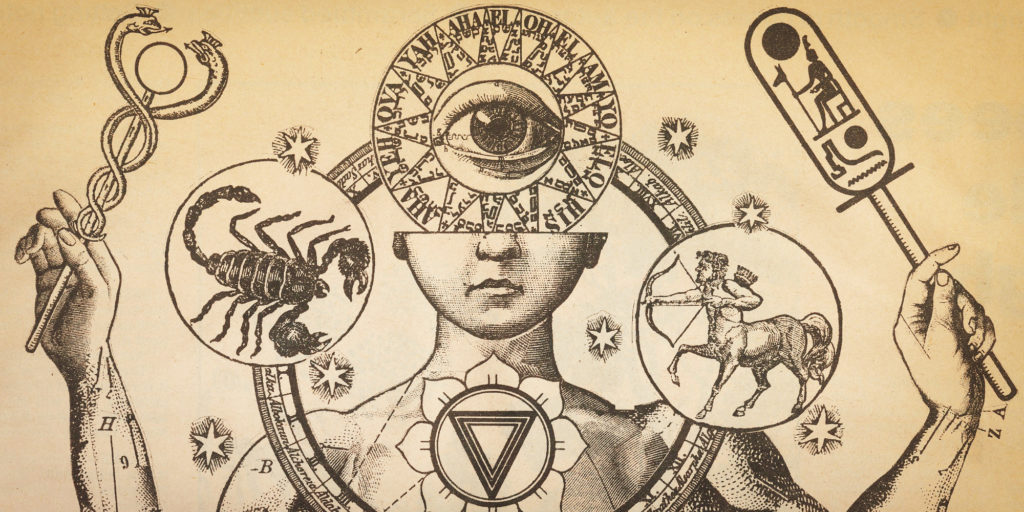Vere tu es Deus absconditus Deus Israhel salvator.
(Indeed, you are a hidden God, you God of Israel, the Savior)
– Book of Isaiah (45:15).
THE THEOLOGICAL ALLEGORY
During the preparational work for ALBE – A Life Beyond Earth (87′, 2018), director Elisa Fuksas and I soon realized we were actually making a “theological film” focused on human solitude and documenting not only the misadventures of a group of people in the province of Rome in search of the “alien”, but also showing what happens in “the province of the mind” where strong beliefs and desires, especially religious, may produce alternative super-realities in people’s lives. The oracular phrase that opens the film “Summoned or not, the god will be present” (from Latin “Vocatus atque non vocatus, Deus aderit”) tries to set this key. I borrowed it from Jung who had it engraved on the stone and placed over the door at his house in Zurich. For the Swiss psychiatrist, it states the inevitability of a spiritual principle in human struggle and research, but also that we are somehow fated to realise our own inner δαίμων (daemon), our own nature. Elisa then was very good to add a poetic allure to the film by putting up the best visual mise–en–scène – saturated colours, a fairy tale style, inside “rationalist” shots – to narrate the stories and the minds of these seven characters in search of a life beyond Earth.

Jung at the main door of his house in Zurich. Note the oracular engravings upon him.
The question “Are we alone (in the Universe)?” is indeed the fil-rouge of the film, a problem to which all religions have always tried to respond to appease people’s anxieties and anguishes. In the current technological civilization these great “narratives” no longer work, but nothing has really replaced them, not even political ideologies. However, the need for “transcendence” remained intact, and even magnifies when it clashes with the “alienating” traits of this culture. So new visions of the world, new beliefs, new “alternative” knowledge to the “official” ones arise in the attempt to redeem the individual from the fear of solitude, insignificance and finitude.
In this scenario, the UFO-belief allegorise in a sci-fi fashion, expectations, codes and figures of historical religions, in particular, the Judaeo-Christian with its eschatology and Manichaeism. Traditional Messianism is re-launched in a cosmic key, and where there was God, today there is the Alien that inherits all its attributes: all-mightyness, omniscience, omnipotence, the great superior intelligence that desires our salvation and to which we aspire to reunite. Also inherits its hide-fullness. The Alien-God is, in fact, the long-awaited par excellence: the Alien-Absconditus.

Painted around 1600 A.D. by artist Ventura Salimbeni, the “Glorification of the Eucharist” is also known as the “Sputnik of Montalcino”.
GLOBAL RELIGION AND SUBCULTURE
When I started doing research for ALBE – A Life Beyond Earth, I didn’t have a clear perception of how wide and pervasive was the UFO belief and related topics. Officially the modern history of flying saucers begins with the case of Roswell in 1947. From then on, the number of people in the world fascinated by the UFO phenomenon has grown relentlessly. In 2010, a Reuters-Ipsos poll involved 23,000 people in 22 countries around the world and showed that 1 out of 5 people (20% of the respondents) believe that extra-terrestrials exist and live incognito among humans. These are impressive numbers. In Italy the percentage sets to 25%, in the US to 24%, still low comparing to the 42% of China and the 45% of India!
Over the last years, theses percentages have even increased. The American population is the one with the highest surge. In 2012 a National Geographic survey records that 36% of American adults (about 80 million) declares they believe in the existence of UFOs; and a 10% assures to have seen one. A more recent Ipsos research from 2015 confirms the trend attesting to 56% the percentage of adult Americans who believe in unidentified flying objects; and to 45% the percentage of those who believe that aliens have visited the Earth.
It is therefore an huge subculture with strong fideistic traits, a global sub-religion, which collects the expectation of something salvific, with a spirit of universal brotherhood (often contradictory). Only later on I realised the UFO religion is something pretty structured with its groupings and sub-groupings.

A frame from “ALBE”. This is a real UFO house in Gallicano (in the province of Rome) build in the 70s by a local for his beloved UFO-enthusiastic wife who died of cancer.
The protagonists of ALBE completely adhere to this scenario. As “terrestrial” they feel to be special, “extra” in fact, and their excitement is similar the vocational ecstasy that affects priests. As the Holy Spirit for traditional believers, they are galvanized because the Alien changed their lives. With this “true-belief” in the hearth they can redeem their existence within a renewed horizon of expectation and hope. They are light-warriors, messengers of truth and love, pioneers of a new era, by which the evil will be destroyed and the good can be finally realized for humanity to re-gain harmony with the Universe and the Cosmos. Eventually the most existential of the questions can also be answered: “What am I doing here?” – await, read signals, prepare for the biggest event to come.
A MODERN (CONSPIRATORIAL) MYTH?
Somehow ALBE – A Life Beyond Earth features what Jung called a “modern myth” in his essay on the UFO phenomenon: Flying Saucers : A Modern Myth of Things Seen in the Skies (1958). When the narrative of the alien visiting Earth spread, and all the newspapers reported news of sightings, Jung wanted to study the phenomenon and his position is actually the one we as authors chose when approaching the stories of our seven characters. Jung’s primary concern was not with the reality or unreality of UFOs but with their psychic aspect. Rather than speculate about their possible nature and extra-terrestrial origin as alleged spacecraft, he asks what it may signify that these phenomena, whether real or imagined, are seen in such numbers just at a time when humankind is menaced as never before in history. In Jung’s words:
“In the threatening situation of the world today, when people are beginning to see that everything is at stake, the projection-creating fantasy soars beyond the realm of earthly organizations and powers into the heavens, into interstellar space, where the rulers of human fate, the gods, once had their abode in the planets […] Even people who would never have thought that a religious problem could be a serious matter that concerned them personally are beginning to ask themselves fundamental questions. Under these circumstances it would not be at all surprising if those sections of the community who ask themselves nothing were visited by `visions,’ by a widespread myth seriously believed in by some and rejected as absurd by others.”
In our relation with the protagonists of the film, Elisa and I have actually suspended every judgment and never thought they were “crazy”, because the question they pose underneath is deeply human and therefore every answer is, if not completely rational, basically legit. Although their stories and beliefs may appear delusional and tragicomic, the desire that animates them is authentic. A form of privileged desire, because it is never fully satisfied, and that produces a strong tension. Like that of faith.
The fundamental point in ALBE is that the film never ridicules the peculiar Weltanschauung of the protagonists, but shows and investigates the reasons that led them to believe in ideas and scenarios commonly considered “impossible” and “laughable”. Because of their self-professed “awaken” status, most of UFO believers refuse existing systems of power and organized religions that deceive the world and kept it in ignorance. Of course this approach flirts with conspiracy culture.

“Alien art” is pretty popular among the UFO subculture.
As God has its alter ego in the (good) Alien, so has the Devil in the form Archont (the evil Alien) and his obscurantist realm ruled by the Illuminati, the reptilian “shape-shifters” and the Masonic lodges. A vision that, by mixing biblical narratives with esoteric and pseudo-scientific elements of various origins, seeks to resolve the great existential questions while unmasking the most hidden political plots. The cultural influences are the most disparate: from David Icke to quantum physics re-interpreted in an archontic way, to Gnostic texts, gothic fairy tales and fantasy novels. A “pastiche” producing all kind of “alternative” theories in any field, such flat-earth theories or “alternative” visions on evolutionism, perhaps borrowed from great Hollywood blockbusters.

An esoteric representation of “alternative” origin of human life and order.
If conspirationism is a way to express an inner hostility (more or less pathological) to any form of authority and to reduce complexity to a simplier and more controllable version, then it’s easy to see why the “extra-terrestrial narration” became so popular. It speaks of utopias and soteriological scenarios of imminent advent, with clean characters, easy moral dichotomies, scapegoats, plots and explanations. It is actually no coincidence that this area is often related to populist movements in the Western world, such as the Five Stars movement in Italy, that arise just at the end of ideologies and traditional parties crisis (seen as the old establishment). The “alien” offers a new palingenetic narration for those who feel threatened, excluded, ignored, who seek for some kind of social redemption.
JUST A MYTH?
But how can one approach such vision of the world so different from the one we normally and rationally embrace? How to interpret the statements of characters who declare – in all honesty – to have entered other dimensions or have been possessed by astral entities or convinced to live in a “Matrix” put up by obscure forces?
John E. Mack, American psychiatrist, Harvard professor, spent a large part of his life dealing with abduction cases, with people who declared they had been “taken away” by alien entities that otherwise couldn’t be diagnosed do be clinically ill. In his best-selling Pulitzer price book Abduction: Human Encounters with Aliens (1994), Mack had collected a large numbers of testimonies taken under hypnosis about adduction experiences, alien encounters and UFO sightings. He was amazed by the richness of details of these stories and made a scientific comparison with cases gathered all over the world noting astounding recurrences. He wondered how it was possible that those stories told by such different kind of people in terms of age, gender, geographical provenience, social status, ethnicity, had so many points in common.

John E. Mack. Note the pinned sheet in the background…
This is something we actually documented in ALBE too. One of the characters, Stefania, a sweet hair-dresser on her 50s, was haunted by alien voices telling they want her to be give birth to a sort of human-alien hybrid who will save the world. We documented an actual “alien-exorcism” performed by a Neapolitan psychotherapist, expert in hypnotic regression. She lost consciousness and started debating with the therapist who tried to free her from the voices. She was relieved at the end of the session, though she never really got rid of the voices. This episode is incredibly similar to some other cases I read in Abduction and other Mack’s books. My personal opinion is that, under certain circumstances, primitive and/or archetypical narrative structures may reactivate taking possession of the person’s mind. Somehow Stefania’s unconscious narrative was that of the “immaculate conception”, a way to give herself a higher purpose beyond daily routine – another attempt to fantasize about a life beyond Earth.

One of “ALBE” character, Stefania, under hypnotic regression.
However, in addressing this kind of phenomena, Mack indeed reprised Jung’s position trying to investigate the existential and/or social preconditions of their occurrences. Yet he pushed himself further. At his own risk. He started to question the Western dualistic/materialist view as well as his own as a scientist. For this reason, he also had some friction with the scientific community and struggled to affirm his point. Mack felt that the UFO phenomenon tested the boundaries of reality. It was neither totally physical nor totally mental – it crossed both dimensions; the UFO was almost like an inter-dimensional vehicle. The physical aspects were that people had been observed to be missing, returning with cuts, ulcers, lesions, etc. But that was not all. It expanded: “to experiences which are more psychological, spiritual, involving the extension of consciousness.” It was in this cross-over that Mack identified the core problem of the phenomenon:
“The difficulty for our society and for our mentality is, we have a kind of either/or mentality. It’s either, literally physical; or it’s in the spiritual other realm, the unseen realm. What we seem to have no place for – or we have lost the place for – are phenomena that can begin in the unseen realm, and cross over and manifest and show up in our literal physical world.”
I personally have hard time to follow Mack’s thought to this extent, yet it is undeniable that beyond our rigorous and rational thinking, there is something more primitive where reality matches illusion, unconstrained desires, fantasy, something that has to do with superstition, belief, a strong need for transcendence and other cognitive attitudes. Sometimes they can awake and even provoke endogenous hallucinatory visions or entheogenic experiences of cosmic proportions – are these true or false at last? In any case, there is a whole bunch of latent and obscure content generally kept away by our daily diurnal approach. Perhaps, for one reason or another, some people leave this “irrational” channel open, in search of some kind of “beyondness”. In this sense, Mack words can be otherwise understood:
“For me everything resides in the matter of identity – who we are in the deepest and broadest sense (…) this book (ed. Abduction: Human Encounters with Aliens) is not simply about UFOs and alien abductions, it is about how this phenomenon both traumatic and transformative can expand our sense of ourselves and our understanding of reality and awaken our muted potential as explorers of a universe rich in mystery, meaning, and intelligence.”
PRODROMES OF AN INTERPLANETARY CIVILIZATION
In my long realation with the protagonist sof ALBE and during the making of the film, when confronting with the candor of their belief I often thought that, even in such naive way, they indeed were some kind of pioneers, the prodromes of a new cosmic awarenss. In the end, the world has shrunk, reality is dominated by the principle of hyper-visibility and transparency, history seems to have come to a dead end and a cyber or transhuman future is scary, There is the pervasive feeling of having arrived at the final chapter or maybbe at a turning point: it is natural then to orient your gaze elsewhere, especially out there, also to rediscover a sense a mystery.

Last scene from “ALBE”: waiting for the aliens to come. Will they show?
Thus we can no longer think of the human event only in the terrestrial key, but already with a sense of perspective beyond the Earth. We must throw ourself beyond the planetary boundaries, imagine other destinations, imagine the mankind to come, after the enormous anthropological mutation that it will undergo, and that he is already undergoing, thanks to technology. We are actually close to conceiving ourselves as an “interplanetary civilization”. The recent discoveries of habitable planets only 40 light years away constitute a watershed, a point of no return in our emotional perception of space out there, a final push to our cosmological centralism. Given the enormous technological development of our observational skills, I believe we are not far from solving the big question about the existence of life in the Cosmos: monstrous coincidence or cosmic imperative? And this will have enormous psychological consequences on each of us, both as individuals and as civilization.
From a scientific point of view, the two classical orientation axes to answer the “are we alone?” question are “the Drake equation”, which calculates the probability of intelligent life beyond the Earth in our galaxy, and the “Fermi paradox”, which asks: “if the probabilities are so high – where is everyone?”. There are various hypotheses for this, but I always love to quote one of the most famous phrases by Carl Sagan:
“The Universe is a pretty big place. If it’s just us, seems like an awful waste of space.”